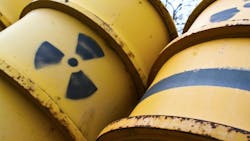The Debate on Nuclear Waste Recycling: Balancing Safety, Efficiency and Environmental Impact
Nuclear energy is a controversial subject. Still, it’s gotten increasing attention as the need for alternative power sources has risen. Nuclear waste recycling has gained particular interest as a way to make the practice more sustainable, but this, too, has met plenty of contention.
As atomic energy grows, the industry must address the waste issue and the possibility of recycling head-on. That means grappling with both the significant promises of nuclear waste recycling and the potential hazards it may pose.
Nuclear Energy’s Waste Problem
Regardless of one’s stance on nuclear waste recycling, it’s easy to see where the impetus behind it comes from. Atomic energy plants hold 250,000 metric tons of radioactive waste across the globe, which poses two key issues.
First, this material’s radiation risks require sophisticated and expensive disposal methods. The federal government is usually responsible for managing high-level waste, but has paid billions of dollars in damages to utilities for failing to do so. Plants can manage lower-risk spent material in-house, but conventional methods still entail high costs and complexity.
The other primary issue with nuclear waste is its unused potential. Fission leaves a significant amount of material holding valuable resources that can still produce additional power, albeit less efficiently. Consequently, conventional atomic energy workflows don’t get all they can out of their raw materials, which are already challenging and expensive to obtain.
Advantages of Nuclear Waste Recycling
Nuclear waste recycling promises a solution to both of these issues. One recent innovation can extract up to 90% of transuranic material from spent fuel rods in just 24 hours. Many new reactors can perform similar work, generating power from used nuclear fuel to reduce their reliance on mined uranium.
Seeing used fuel as an expendable resource would allow reactors to minimize their waste that otherwise sits idle on facility grounds for years or requires expensive disposal. In addition to reducing radiation risks around these storage areas, this strategy would make atomic power more cost-effective. Renewable energy could become increasingly accessible as a result.
Recycling would also lower the need for uranium mining. All mining workflows are energy-intensive and can contaminate the surrounding environment, but radioactive materials pose additional problems. While uranium mining has become safer with new practices, old mines have led to considerable groundwater contamination through leftover radon and radium dust. Reducing mining activity could minimize such risks.
Potential Risks of Nuclear Waste Recycling
Despite being both cost-effective and environmentally beneficial, nuclear waste recycling is far from a cut-and-dry issue. One of the biggest concerns is that reprocessing fuel rods and pellets produces plutonium, a key component of nuclear weapons.
Creating enough weapons-grade plutonium takes 30 megawatt-years of reactor processing by conventional means, making it challenging to obtain. However, wide-scale waste recycling could make this material more accessible. That accessibility may raise concerns over the threat of atomic warfare.
The reprocessing necessary to ready spent fuel for recycling also produces its own waste. Increased touchpoints lead to additional radiation risks, too. While the total waste is less than what plants would have otherwise, some organizations question whether the heightened risks and complications are worth it if it doesn’t eliminate radioactive leftovers.
What’s Next for Nuclear Energy?
Recent advances may assuage some of these concerns. A 2023 study found that a novel recycling process can use 90% of high-level waste, while canisters stored deep underground can manage the remaining 10%. This hybrid approach would minimize both overall waste and the risk of leftover plutonium to address weapons-related concerns.
New regulations around these processes may be necessary. When nuclear waste recycling is a more closely monitored practice, it holds power plants accountable for ensuring safe disposal, efficient reuse and secure supply chain assurance. Greater attention and publicity on the subject could encourage such legislation.
Government officials have taken a renewed interest in atomic power and recycling lately. In late 2024, the Department of Energy announced $10 million in funding for nuclear fuel recycling research and development. This investment could lead to innovations that improve recycling efficiency or reduce plutonium-related risks while making the practice more accessible for power plants.
A bipartisan bill introduced that same month aims to reclassify nuclear reprocessing equipment, which would streamline nuclear waste recycling licensing. Should the bill pass, it could clear the way for faster expansion of these reactors. This growth, in turn, could lead to increased investment in recycling, potentially advancing the technology further to overcome some of its current challenges.
Nuclear Waste Recycling Is Contentious but Promising
Nuclear waste recycling is still new, so it will take additional time, research and investment before it’s ready for widespread use and public approval. Its risks demand attention, but at the same time, it’s hard to overlook its potential. Atomic energy plants should approach it with caution but not write it off yet.
The concerns facing nuclear recycling are legitimate, but possible answers are on the horizon. When the industry pays enough attention to both sides of the issue, it can forge a responsible path forward. Learning about the opportunities and shortcomings is the first step in that process.
About the Author
Ellie Gabel
Ellie Gabel is a writer based in the Washington DC area. She is associated editor at Revolutionized and specializes in writing about environmental science.
